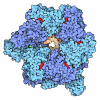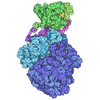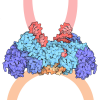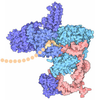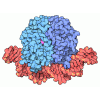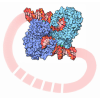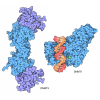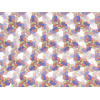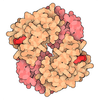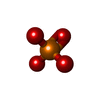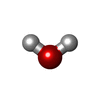[English] 日本語
 Yorodumi
Yorodumi- PDB-9d5l: The C-terminal domain of Thiopseudomonas alkaliphila Tn7 TnsE bou... -
+ Open data
Open data
- Basic information
Basic information
| Entry | Database: PDB / ID: 9d5l | |||||||||
|---|---|---|---|---|---|---|---|---|---|---|
| Title | The C-terminal domain of Thiopseudomonas alkaliphila Tn7 TnsE bound to DNA | |||||||||
 Components Components |
| |||||||||
 Keywords Keywords | DNA BINDING PROTEIN/DNA / Tn7 / target-site selector / DNA BINDING PROTEIN / DNA BINDING PROTEIN-DNA complex | |||||||||
| Function / homology | PHOSPHATE ION / DNA / DNA (> 10) Function and homology information Function and homology information | |||||||||
| Biological species |  Thiopseudomonas alkaliphila (bacteria) Thiopseudomonas alkaliphila (bacteria)synthetic construct (others) | |||||||||
| Method |  X-RAY DIFFRACTION / X-RAY DIFFRACTION /  SYNCHROTRON / SYNCHROTRON /  MOLECULAR REPLACEMENT / Resolution: 2.8 Å MOLECULAR REPLACEMENT / Resolution: 2.8 Å | |||||||||
 Authors Authors | Krishnan, S.S. / Guarne, A. | |||||||||
| Funding support |  Canada, 2items Canada, 2items
| |||||||||
 Citation Citation |  Journal: Nucleic Acids Res / Year: 2025 Journal: Nucleic Acids Res / Year: 2025Title: Asymmetric loading of TnsE regulates Tn7 targeting of DNA replication structures. Authors: Shreya S Krishnan / Yao Shen / Treasa B O'Hagan / Lindsay A Matthews / Nuwani W Weerasinghe / Rodolfo Ghirlando / Christopher J Thibodeaux / Alba Guarné /   Abstract: Tn7 transposable elements are known for their sophisticated target-site selection mechanisms. For the prototypical Tn7 element, dedicated transposon-encoded proteins direct insertions to either a ...Tn7 transposable elements are known for their sophisticated target-site selection mechanisms. For the prototypical Tn7 element, dedicated transposon-encoded proteins direct insertions to either a conserved site in the chromosome or replicating DNA structures in conjugal plasmids, ensuring the vertical and horizontal spread of the element. While the pathway targeting the attTn7 site in the bacterial chromosome has been extensively studied, the pathway targeting DNA replication structures remains poorly understood. We have used an integrative structural biology approach to elucidate how the Tn7-encoded protein TnsE recognizes replication sites. Using native mass spectrometry, we found that TnsE forms 1:1 and 2:1 (TnsE:DNA) complexes on 3'-recessed DNA, with gain-of-function TnsE variants favoring the formation of 2:1 complexes. Structural characterization confirms that two TnsE molecules bind to DNA with the C-terminal domain of the protein recognizing duplex DNA, leaving the N-terminal domain to impose DNA substrate specificity and recruit the core transposition machinery. Collectively, our work is consistent with a model where TnsE-mediated target-site selection relies on the formation of an asymmetric TnsE:DNA complex to recruit the Tn7 transposase to DNA replication structures. | |||||||||
| History |
|
- Structure visualization
Structure visualization
| Structure viewer | Molecule:  Molmil Molmil Jmol/JSmol Jmol/JSmol |
|---|
- Downloads & links
Downloads & links
- Download
Download
| PDBx/mmCIF format |  9d5l.cif.gz 9d5l.cif.gz | 103.8 KB | Display |  PDBx/mmCIF format PDBx/mmCIF format |
|---|---|---|---|---|
| PDB format |  pdb9d5l.ent.gz pdb9d5l.ent.gz | 63.1 KB | Display |  PDB format PDB format |
| PDBx/mmJSON format |  9d5l.json.gz 9d5l.json.gz | Tree view |  PDBx/mmJSON format PDBx/mmJSON format | |
| Others |  Other downloads Other downloads |
-Validation report
| Summary document |  9d5l_validation.pdf.gz 9d5l_validation.pdf.gz | 436.5 KB | Display |  wwPDB validaton report wwPDB validaton report |
|---|---|---|---|---|
| Full document |  9d5l_full_validation.pdf.gz 9d5l_full_validation.pdf.gz | 436.4 KB | Display | |
| Data in XML |  9d5l_validation.xml.gz 9d5l_validation.xml.gz | 9.3 KB | Display | |
| Data in CIF |  9d5l_validation.cif.gz 9d5l_validation.cif.gz | 12 KB | Display | |
| Arichive directory |  https://data.pdbj.org/pub/pdb/validation_reports/d5/9d5l https://data.pdbj.org/pub/pdb/validation_reports/d5/9d5l ftp://data.pdbj.org/pub/pdb/validation_reports/d5/9d5l ftp://data.pdbj.org/pub/pdb/validation_reports/d5/9d5l | HTTPS FTP |
-Related structure data
| Related structure data | C: citing same article ( |
|---|---|
| Similar structure data | Similarity search - Function & homology  F&H Search F&H Search |
- Links
Links
- Assembly
Assembly
| Deposited unit | 
| ||||||||||||
|---|---|---|---|---|---|---|---|---|---|---|---|---|---|
| 1 | 
| ||||||||||||
| Unit cell |
|
- Components
Components
| #1: Protein | Mass: 19230.975 Da / Num. of mol.: 1 Source method: isolated from a genetically manipulated source Source: (gene. exp.)  Thiopseudomonas alkaliphila (bacteria) / Production host: Thiopseudomonas alkaliphila (bacteria) / Production host:  |
|---|---|
| #2: DNA chain | Mass: 3659.440 Da / Num. of mol.: 1 / Source method: obtained synthetically Details: The DNA used in the crystallization condition was a 3'-recessed DNA substrate formed by annealing a 48-nt (5'-GCAAGGCCGGAAACGTCACCAATGCAACGATCAGCCAACTAAACTAGG-3') and a 24-nt (5'- ...Details: The DNA used in the crystallization condition was a 3'-recessed DNA substrate formed by annealing a 48-nt (5'-GCAAGGCCGGAAACGTCACCAATGCAACGATCAGCCAACTAAACTAGG-3') and a 24-nt (5'-CCTAGTTTAGTTGGCTGATCGTTG-3') resulting in a 24 bp double-strand and 24 nt single-strand portion. The asymmetric unit contains one molecule of TaTnsE-CTD and a DNA strand (12 nt) that forms a DNA duplex by crystal symmetry and propagates as a pseudo-continuous duplex. This arrangement resulted in the asymmetric unit representing an average of the protein binding along the entire duplex, precluding the assignment of the DNA register and washing out the signal for the 5' single-strand DNA tail. We have modelled a string of T/A basepairs to reflect the lack of registry. Source: (synth.) synthetic construct (others) |
| #3: Chemical | ChemComp-PO4 / |
| #4: Water | ChemComp-HOH / |
| Has ligand of interest | N |
| Has protein modification | N |
| Sequence details | The DNA used in the crystallization condition was a 3'-recessed DNA substrate formed by annealing a ...The DNA used in the crystallization condition was a 3'-recessed DNA substrate formed by annealing a 48-nt (5'-GCAAGGCCGG |
-Experimental details
-Experiment
| Experiment | Method:  X-RAY DIFFRACTION / Number of used crystals: 1 X-RAY DIFFRACTION / Number of used crystals: 1 |
|---|
- Sample preparation
Sample preparation
| Crystal | Density Matthews: 2.83 Å3/Da / Density % sol: 56.49 % |
|---|---|
| Crystal grow | Temperature: 295 K / Method: vapor diffusion, sitting drop / Details: Sodium Iodide, Bis-Tris propane, PEG 3350 |
-Data collection
| Diffraction | Mean temperature: 100 K / Serial crystal experiment: N |
|---|---|
| Diffraction source | Source:  SYNCHROTRON / Site: SYNCHROTRON / Site:  CLSI CLSI  / Beamline: 08B1-1 / Wavelength: 1.0332 Å / Beamline: 08B1-1 / Wavelength: 1.0332 Å |
| Detector | Type: RAYONIX MX300HE / Detector: CCD / Date: Jun 29, 2019 |
| Radiation | Protocol: SINGLE WAVELENGTH / Monochromatic (M) / Laue (L): M / Scattering type: x-ray |
| Radiation wavelength | Wavelength: 1.0332 Å / Relative weight: 1 |
| Reflection | Resolution: 2.8→49.38 Å / Num. obs: 7169 / % possible obs: 99.6 % / Redundancy: 38.4 % / Biso Wilson estimate: 61.71 Å2 / CC1/2: 0.995 / Net I/σ(I): 9.03 |
| Reflection shell | Resolution: 2.8→2.9 Å / Num. unique obs: 702 / CC1/2: 0.42 |
- Processing
Processing
| Software |
| ||||||||||||||||||||||||||||||||||||||||||
|---|---|---|---|---|---|---|---|---|---|---|---|---|---|---|---|---|---|---|---|---|---|---|---|---|---|---|---|---|---|---|---|---|---|---|---|---|---|---|---|---|---|---|---|
| Refinement | Method to determine structure:  MOLECULAR REPLACEMENT / Resolution: 2.8→49.38 Å / SU ML: 0.498 / Cross valid method: FREE R-VALUE / σ(F): 1.34 / Phase error: 29.5255 MOLECULAR REPLACEMENT / Resolution: 2.8→49.38 Å / SU ML: 0.498 / Cross valid method: FREE R-VALUE / σ(F): 1.34 / Phase error: 29.5255 Stereochemistry target values: GeoStd + Monomer Library + CDL v1.2
| ||||||||||||||||||||||||||||||||||||||||||
| Solvent computation | Shrinkage radii: 0.9 Å / VDW probe radii: 1.11 Å / Solvent model: FLAT BULK SOLVENT MODEL | ||||||||||||||||||||||||||||||||||||||||||
| Displacement parameters | Biso mean: 67.48 Å2 | ||||||||||||||||||||||||||||||||||||||||||
| Refinement step | Cycle: LAST / Resolution: 2.8→49.38 Å
| ||||||||||||||||||||||||||||||||||||||||||
| Refine LS restraints |
| ||||||||||||||||||||||||||||||||||||||||||
| LS refinement shell |
|
 Movie
Movie Controller
Controller



 PDBj
PDBj
